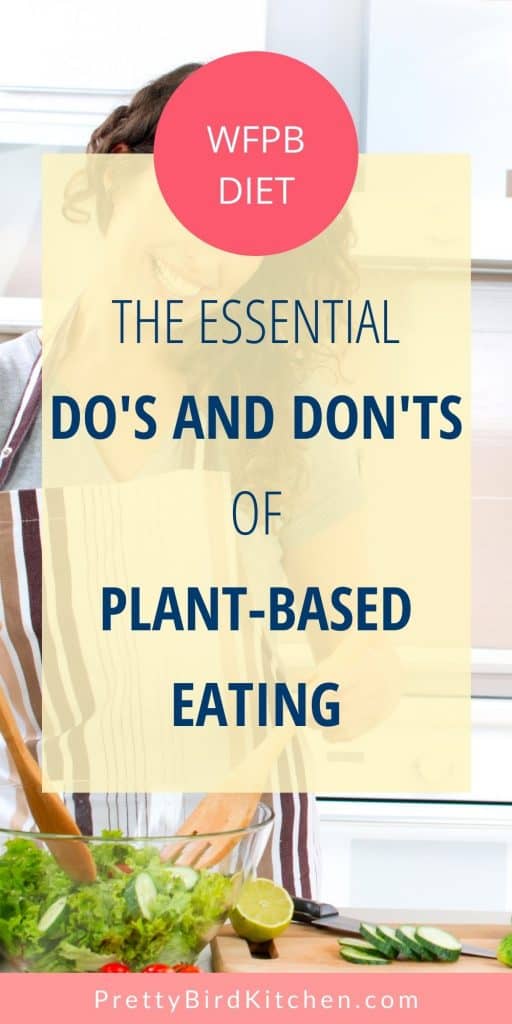The Do’s and Don’ts of Plant-Based Eating
New to a whole food, plant-based lifestyle? It can be confusing, for sure! Here are some of the key do’s and don’ts of plant-based eating so you know how to do it the right way.

This post may contain affiliate links. See my full disclosure here.
Disclaimer: I am not a nutritionist or a healthcare professional. You can read about our personal experience with a plant-based diet, but please know that your experience may be different from ours. You should do your own research before making any changes to your diet or lifestyle especially if you have a health condition.
Do you know what you can and can’t eat on a whole food, plant-based diet? It’s okay if you’re still a little fuzzy on the details. In this post, I’ll explain what is and isn’t acceptable on a whole food, plant-based diet so you know you’re eating the right things.
Note: If you need help starting your plant-based diet, then you’ll want to grab my free Plant-Based Quick Start Guide below!

Get my FREE plant-based quick start guide
If you aren’t sure where to begin with your whole food, plant-based diet, then this step-by-step guide will help.
The Do’s of Plant-Based Eating
First things first. Here are the do’s of plant-based eating.
DO: Eat a Wide Variety of plant foods
Here are some examples of plant foods:
- Fruit: apples, bananas, oranges, kiwi, strawberries, blueberries, mangoes, lemons, watermelon, cantaloupe, grapes, pears, etc.
- Vegetables: broccoli, kale, spinach, lettuce, carrots, beets, onions, potatoes, squash, corn, cauliflower, cucumber, asparagus, celery, garlic, collard greens, etc.
- Whole grains: brown rice, quinoa, whole wheat, oats, rye, barley, etc.
- Legumes: black beans, kidney beans, chickpeas (garbanzo beans), lima beans, lentils, pinto beans, etc.
- Nuts and seeds: walnuts, almonds, pecans, sunflower seeds, cashews, pine nuts, hemp seeds, etc.
You want to eat a range of foods from each category so you get all the different vitamins and minerals each food has to offer. Eating only bananas from the fruit category, for example, means you’re missing out on all the nutrients found in berries and other fruits.
Mix it up and explore new foods! You might find some new favorites.
Do: Eat the Rainbow
Make your plate as colorful as possible. You’ve probably heard nutritional gurus touting the benefits of eating the rainbow, and that’s because brightly colored foods are known to have more nutrients than bland-colored foods. Dark leafy greens are loaded with vitamins and minerals, and vibrant berries are rich in antioxidants.
By making your plate colorful, you’re maximizing the nutrients you get with each bite.
Do: Eat Plant Foods that are Minimally Processed
You want to choose plant foods that are either whole or minimally processed, meaning they closely resemble the original food nature created.
A good example is a potato.
- A baked potato is minimally processed because all you did was heat up the potato to make the starches in it more digestible.
- A French fry from McDonald’s, however, is highly processed because the potato has been fried in oil and has preservatives added to it.
It helps to think of food processing as a linear scale. On the one end of the scale you have the raw food straight from nature. This might be an apple or a tomato or a freshly cracked walnut. This is what we’d call a “whole food.”
As you move along the scale, the food undergoes different levels of processing. An apple might be dried to make dried apple rings, or a potato might be baked to make the starches more digestible. These processing methods are still okay because they make the foods more edible and don’t significantly alter the food itself. This is what we’d call “minimally processed.”
The far end of the scale is what you want to avoid. This is where that apple gets turned into a shelf-stable apple pie you can buy from the supermarket. Or the potato gets turned into a greasy bag of potato chips complete with added preservatives. This is what we’d call “highly processed“
A good rule of thumb is this:
If it is a plant, eat it. If it’s made in a [processing] plant, don’t.
The Don’ts of Plant-Based Eating
And now for the don’ts of plant-based eating.
Don’t: Eat Animal Products
A whole food, plant-based diet excludes all animal food products such as meat, seafood, eggs, and dairy products.
Here are some examples of animal products:
- Meat: fish, shellfish, chicken, turkey, pork, beef, bison, etc.
- Dairy: milk, cheese, yogurt, cream cheese, heavy cream, butter, etc.
- Eggs
- Lard
The only exception to this rule is honey. Unless you also consider yourself vegan in addition to eating a whole food, plant-based diet, then honey is generally accepted as an okay sweetener even though it is technically an animal product.
Don’t: Eat Highly Processed Foods
A whole food, plant-based diet excludes highly processed foods such as bleached flour, white sugar, white rice, and added oils.
Even though some of these foods technically come from plants, they aren’t in their whole forms. They’ve been processed and stripped to the point that they lack any nutritional value.
Here are some examples of highly processed products:
- Oils: canola, vegetable, peanut, corn, etc.
- Refined Grains: white pasta, white rice, white bread, bleached flour, crackers, etc.
- Refined Sweeteners: white sugar, high fructose corn syrup, brown sugar, dextrose, etc.
- Prepackaged snacks: cakes, pastries, candy, chips, etc.
- Boxed foods: mac and cheese, rice sides, frozen pizza, frozen dinners, etc.
Remember that rule of thumb we talked about earlier? The foods I just listed would fall under the category of highly processed because they’ve been manufactured in a processing plant and hardly resemble the foods nature originally created.
Don’t: Count Calories
Probably my favorite part of eating a whole food, plant-based diet is that you don’t have to count calories.
You see, plant foods are naturally low in calories, so even if you eat a whole plate of fruit and veggies, you’re consuming far fewer calories than you would if you ate a whole plate of fast food.
Why?
Because meat, dairy products, and highly processed foods are more calorically-dense than plant foods. And the reason is because they usually contain higher levels of fat.
Let’s dive down a rabbit hole really quickly so you understand the concept of caloric density.
Foods can be divided up into three main macronutrients: fat, protein, and carbohydrates.
Fat supplies more than twice as many calories per gram when compared to carbohydrates and proteins. Carbohydrates and proteins each have 4 calories per gram, while fat has 9 calories per gram. (Source)
Foods that are high in fat include meat; dairy products; oils (which are present in most processed foods); and certain plant foods such as nuts, seeds, and avocados.
So when a food has more fat in it, either naturally or artificially through processing, it contains more calories than foods without as much fat in them.
Since fruit, vegetables, whole grains, and legumes have much less fat in them AND since these are the foundational foods of the whole food, plant-based diet, you’ll naturally consume far fewer calories eating this way than when eating the Standard American Diet. That’s why you don’t need to count calories.
If you’d like to explore this topic further, you can read these posts:
- The Complete Guide to Dietary Fats (the simple version!)
- 9 Sources of Healthy Plant-Based Fats You Should Always Have in Your Kitchen
Frequently Asked Questions
Here are some questions you might have when you’re new to the plant-based diet.
Can I have oil on a whole food, plant-based diet?
Oil is a controversial topic in the plant-based community. Some plant-eaters avoid it 100% of the time, others consume select oils in small quantities, and still others consume it without abandon.
If you want the “right answer,” then you should know that many of the important plant-based doctors recommend no oil because oil is highly processed, nutritionally deficient, and contributes unnecessary calories to your diet. You can read these two articles from NutritionStudies.org to explore their reasoning further:
So of course, the “right way” to eat a perfectly whole food, plant-based diet is to avoid all oil, all the time.
Now, if you’re like me, you might think that this is an unrealistic standard to uphold at all times. It’s a great thing to aspire to, but you might be okay sacrificing perfection for the sake of convenience every now and then.
With that said, my personal motto is “progress, not perfection.” I try to avoid oil as much as possible, but I do still keep a small bottle of extra virgin olive oil in my kitchen for select recipes that I know won’t turn out right without any oil.
I think the important thing to consider is your personal goals and what you want out of your plant-based diet. If you want to strive for perfection, then you’ll want to avoid all oils. If you just want to make better choices without feeling pressured to be perfect, then you might be okay having small cheats here and there.
There are plenty of us who choose the latter, so feel free to do what’s best for you and your family.
Should I Avoid High-Fat Plant Foods?
After exploring the concept of caloric density, you might be wondering if you should avoid high-fat plant foods. Namely, nuts, seeds, avocados, and coconut, which are naturally higher in fat than other plant foods.
The answer to this question, again, depends on your personal goals.
If you are trying to lose weight, then you’ll want to limit or even avoid these high-fat plant foods until you reach your goal weight. This is what the prominent plant-based doctors recommend.
If you’re already a healthy weight, then you do not have to avoid these foods. Good fats such as monounsaturated and polyunsaturated fats (which are found in high-fat plant foods) support brain function, healthy skin, better mood, and so much more! (Source)
You don’t need to be afraid of high-fat plant foods. Just keep an eye on your weight and adjust your consumption of them if you notice any weight gain.
Final Thoughts on How to Eat a Whole Food, Plant-Based Diet
So now you know what’s acceptable on a whole food, plant-based diet! You know what you should eat and what you should avoid to make the most of your plant-based lifestyle. You also know where the prominent plant-based doctors stand on the topic of oil, and whether you should avoid high-fat plant foods.
If you have any questions, feel free to ask them in the comment section. I personally reply to each one!
And to further your plant-based knowledge, check out these other resources:
Other Plant-Based Articles You Might Enjoy
- How to Afford a Plant-Based Diet on a Budget
- Plant-Based vs. Vegan: The Major Differences You Need to Know About
- Plant-Based Shopping List: What to Buy When You Follow a Plant-based Diet
- 26 Affordable Plant-Based Foods to Buy at ALDI
What do you find confusing about the whole food, plant-based diet? Let me know in the comments!

Want to remember this? Save it to your favorite Pinterest board by clicking the images below!

